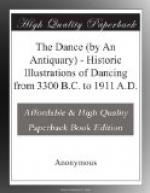In the rites of Dionysius the chorus was fifty and the cithara was used instead of the flute. From the time of Sophocles it was fifteen, and always had a professed trainer. The choric question is, however, a subject in itself, and cannot be fairly dealt with here. The social dances, and those in honour of the seasons, fire and water, were numerous and generally local; whilst the chamber dances, professional dancing, the throwing of the Kotabos, and such-like, must be left to the reader’s further study of the authors mentioned in the bibliography at the end of the work.
[Illustration: Fig. 18.—Greek dancers and tumblers.]
It may astonish the reader to know that the funambulist or rope-dancer was very expert with the Greeks, as also was the acrobat between knives and swords. Animals were also taught to dance on ropes, even elephants.
The important religious and other dances were not generally composed of professionals. The greatest men were not above showing their sentiments by dancing. Sophocles danced after Salamis, and Epaminondas was an expert dancer. There were dancers of all grades, from the distinguished to the moderate. Distinguished persons even married into excellent positions, if they did not already occupy them by birth. Philip of Macedon married Larissa, a dancer, and the dancer Aristodemus was ambassador to his Court. These dancers must not be confounded with those hired to dance at feasts, etc. (figs. 9, 14 and 18). [Illustration: Fig. 19.—Etruscan bronze dancer with eyes of diamonds, found at Verona. Now in the British Museum.]
CHAPTER III.
ETRUSCAN-SOUTH ITALIAN, ROMAN DANCING, ETC.
One of the most important nations of antiquity was the Etruscan, inhabiting, according to some authorities, a dominion from Lombardy to the Alps, and from the Mediterranean to the Adriatic.
Etruria gave a dynasty to Rome in Servius Tullius, who originally was Masterna, an Etruscan.
[Illustration: Fig. 20.—Etruscan dancer. From a painting in the Grotta dei Vasi dipinti—Corneto.]
It is, however, with the dancing that we are dealing. There is little doubt that they were dancers in every sense; there are many ancient sepulchres in Etruria, with dancing painted on their walls. Other description than that of the pictures we do not possess, for as yet the language is a dead letter. There is no doubt, as Gerhardt [Footnote: “Ann. Institut.”: 1831, p. 321.] suggests, that they considered dancing as one of the emblems of joy in a future state, and that the dead were received with dancing and music in their new home. They danced to the music of the pipes, the lyre, the castanets of wood, steel, or brass, as is shown in the illustrations taken from the monuments.
[Illustration: Fig. 21.—Etruscan dancing and performances. From paintings in the Grotta della Scimia Corneto, about 500 B.C.]




